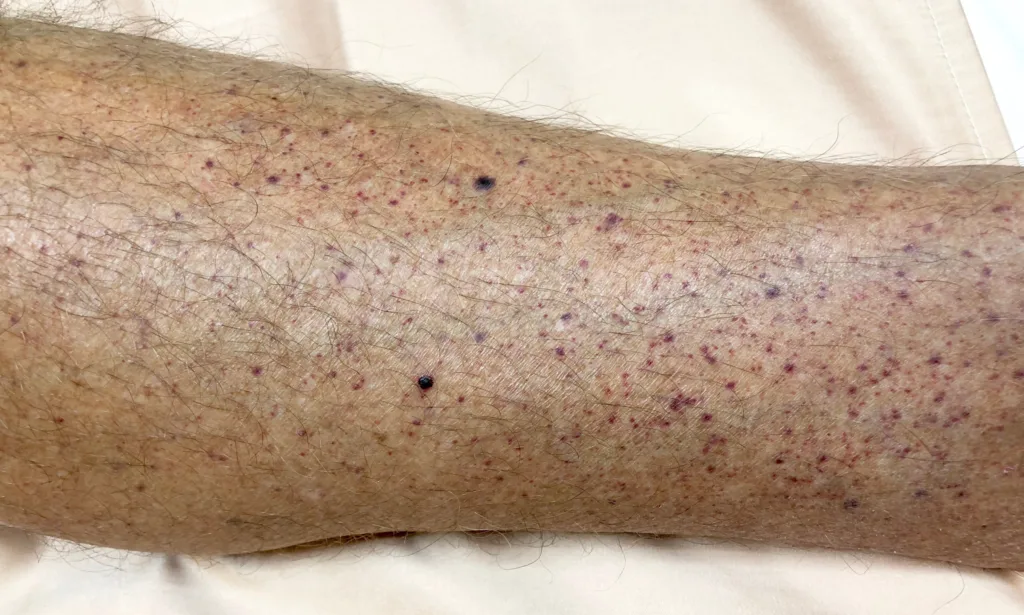Petechiae are small, flat red or purple spots that can appear on the skin or in the mucous membranes. They are caused by bleeding under the skin, often due to a minor injury or trauma. While petechiae are generally harmless and will go away on their own, they can sometimes be a sign of an underlying medical condition.
Petechiae can be caused by a variety of factors, such as infections, medications, and medical conditions. Some common causes of petechiae include:
– Infections: Fungal, viral, and bacterial infections can all cause petechiae. For example, cytomegalovirus (CMV) infection, endocarditis, and meningococcemia can all lead to petechiae.
– Medications: Certain medications, such as blood thinners, can cause petechiae as a side effect.
– Medical conditions: Petechiae can be a symptom of several medical conditions, including leukemia, thrombocytopenia, and vasculitis.
In most cases, petechiae are nothing to worry about and will go away on their own wthin a week or two. However, if you notice petechiae along with other symptoms, or if they are widespread, it is important to seek medical attention.
Some signs that your petechiae may be a cause for concern include:
– They are accompanied by other symptoms, such as fever, fatigue, or joint pain.
– They are widespread or appear in unusual places, such as on the palms of your hands or the soles of your feet.
– They do not go away within a week or two.
– You have a history of bleeding disorders or blood clotting problems.
If you are experiencing any of these symptoms, it is important to see a doctor right away. They can help determine the underlying cause of your petechiae and recommend appropriate treatment.
In some cases, petechiae can be a sign of a serious medical condition, such as leukemia or meningococcemia. These conditions require prompt medical attention and treatment.
Petechiae are generally harmless and will go away on their own. However, if you notice petechiae along with other symptoms or if they are widespread, it is important to see a doctor right away. They can help determine the underlying cause of your petechiae and recommend appropriate treatment.
Can Petechiae Be Nothing To Worry About?
Petechiae can be nothing to worry about in many cases. They are small, flat, red or purple spots on the skin that occur due to bleeding undr the skin. They are often caused by minor trauma, such as a hard cough or vomiting, and will usually disappear on their own within a few days. However, if petechiae occur frequently or are accompanied by other symptoms such as fever, fatigue, or pain, it may be a sign of an underlying medical condition that requires medical attention. Some of the medical conditions that may cause petechiae include infections, autoimmune disorders, and bleeding disorders. Therefore, it is always best to consult a healthcare provider if you are concerned about petechiae or if they do not go away on their own.

Why Am I Getting Petechiae All Of A Sudden?
Petechiae are small, flat red or purple spots that appear on the skin or mucous membranes. They can occur due to a number of reasons, some of which include infections, such as viral, bacterial, or fungal infections, medications, autoimmune disorders, or trauma. In some cases, petechiae can indicate serious conditions, such as meningitis, sepsis, or certain types of cancer.
If you are suddenly experiencing petechiae, it is important to seek medical attention immediately. Your doctor will perform a physical exam and may recommend blood tests or oher diagnostic tests to determine the underlying cause. Treatment will depend on the underlying cause, and may involve medication, lifestyle changes, or other interventions.
It is important to note that petechiae can be a symptom of a serious condition, and should not be ignored. If you are experiencing petechiae or any other unusual symptoms, it is important to seek medical attention promptly.
How Do I Know If My Petechiae Is Harmless?
Petechiae are usually harmless and go away on their own within a few days. However, if you experience more than one episode of petechiae, or if they appear aong with other symptoms such as fever, headache, or joint pain, it’s important to seek medical attention. Your doctor will perform a physical exam and may order blood tests, a bone marrow biopsy, or other diagnostic tests to determine the underlying cause of your petechiae. Some conditions that cause petechiae, such as blood disorders or infections, may require treatment to prevent complications. If you have any concerns about your petechiae, it’s best to consult your doctor to ensure proper diagnosis and treatment.
Is A Small Amount Of Petechiae Normal?
A small amount of petechiae is normal in some cases. Petechiae are tiny red or purple spots that appear on the skin and are caused by bleeding under the skin. They can be caused by a variety of factors, including minor injuries, allergic reactions, and even vigorous exercise. In most cases, petechiae are harmless and will go away on their own within a few days. However, if you notice a sudden onset of petechiae or they are accompanied by other symptoms, such as fever or fatigue, it’s important to seek medical attention as they could be a sign of a more srious underlying condition.
Conclusion
Petechiae can be a concerning symptom when they appear on your skin. While they can be harmless and resolve on their own, they can also be a sign of an underlying medical condition that requires attention. It’s important to be aware of the potential causes of petechiae, including infections and serious medical conditions. If you notice petechiae on your skin, it’s always a good idea to consult with your doctor to determine the underlying cause and any necessary treatment. Remember, early detection and treatment can prevent potential complications and ensure your overall health and well-being.
